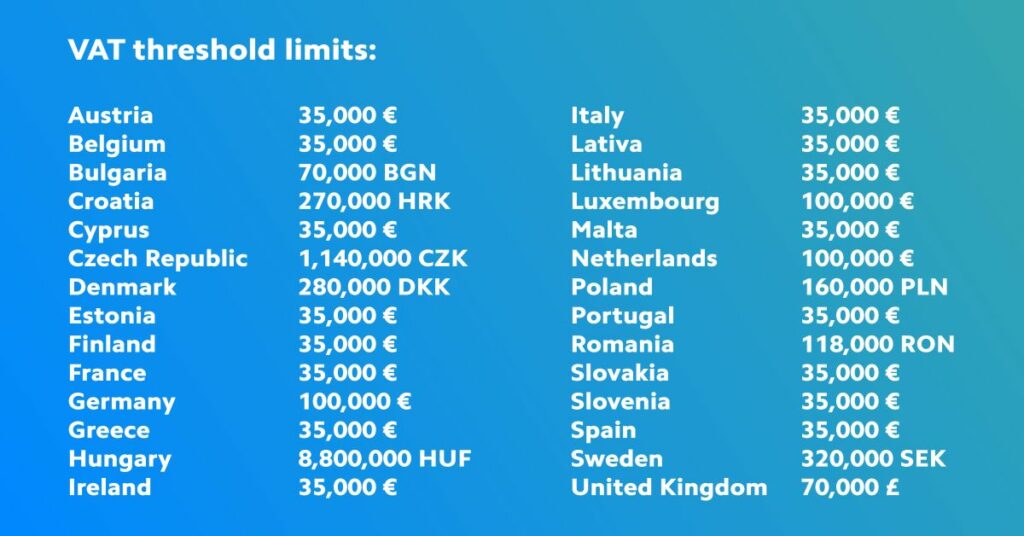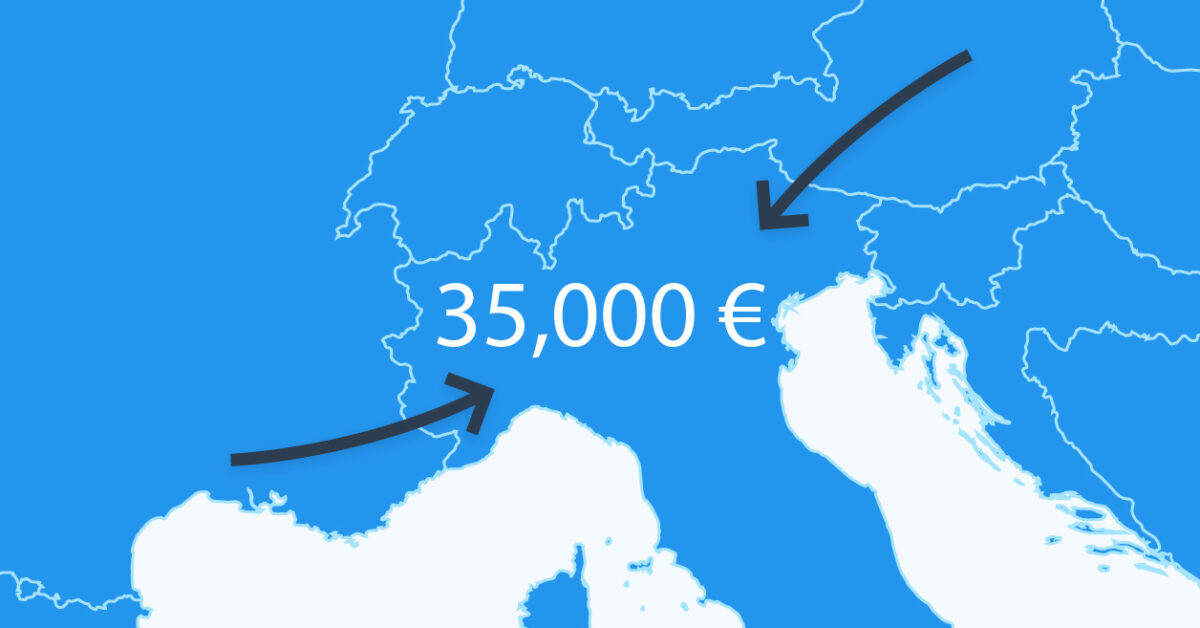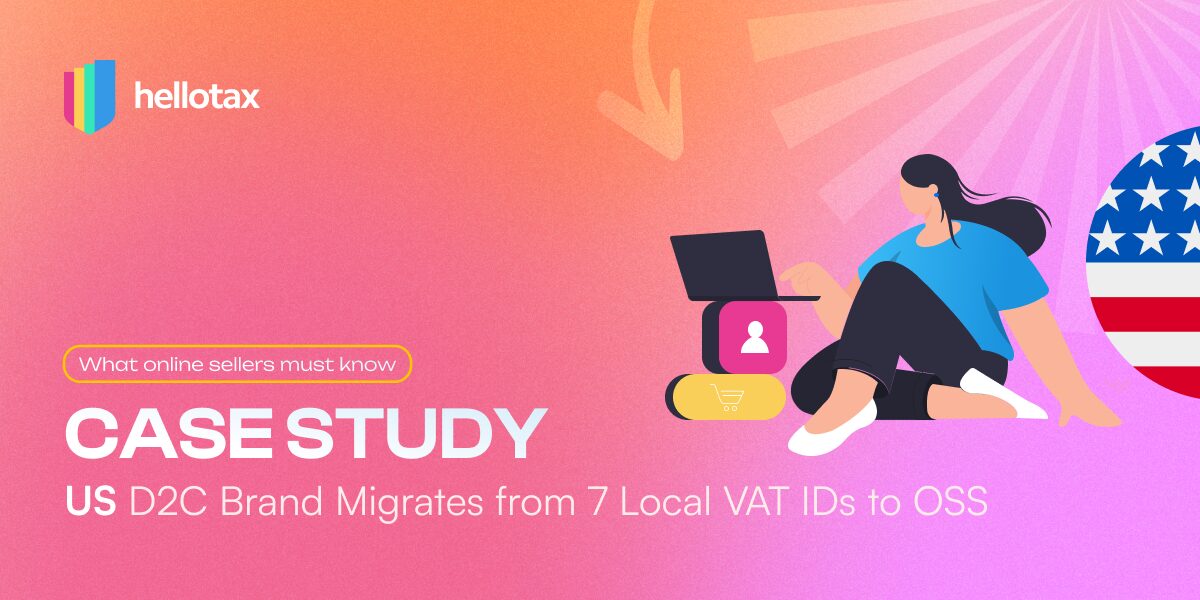Online selling and mail order services have been increasing ever since. People all over Europe order millions of packages every day on Amazon, and of course, many of these orders are transborder sales. As a seller, distance selling in Europe may result in tax duties. In this article, we will explain everything you need to know about Distance Selling in Europe.
Antonia Klatt
Last Updated on 31 January 2022
What is Distance Selling in Europe?
Aside from establishing a business or storing goods in another country, exceeding the EU-wide threshold for cross-border B2C distance sales can also trigger VAT registration obligations.
UPDATE: Starting from the 1st of July 2021 a Europe-wide unform delivery treshold of 10,000€ was introduced and replaced the previous country-specific thresholds. This had several consequences for online retailers. The €10,000 threshold is cumulative across all EU countries. For example, if you sell goods from Germany to Spain (€5,000), France (€5,000), and Poland (€1,000), you exceed the threshold and must apply the local VAT rates in each destination country. You must either register for VAT in those countries or use the One Stop Shop (OSS) scheme.
Distance Selling Threshold Limits in Europe
Selling from the country you are VAT registered in is fine until you reach the threshold within one calendar year. Previously, country-specific thresholds applied. Since 1 July 2021, a single EU-wide threshold of €10,000 applies for distance sales under the OSS scheme. Additionally, from 1 January 2025, an optional SME VAT exemption scheme introduces a €100,000 threshold for eligible small enterprises.
Reaching the annual threshold limit for distance selling leads to various VAT duties. That’s why reaching this limit should not be missed to avoid problems (and penalties) before they even happen.
This is an old table that does not apply anymore but It has been left here for the record:

Example for Distance Selling from Germany
You are an online seller based in Germany and sell to several European countries. The products you sell online to the Netherlands are worth 50 000€. This was previously not a problem.
Previously, Germany’s domestic threshold for local VAT registration was €100,000. However, this no longer applies for cross-border distance selling. Since July 1, 2021, once total EU-wide B2C sales exceed €10,000, VAT must be charged based on the customer’s country
If your total cross-border sales within the EU exceed €10,000, you must charge VAT based on the customer’s location. To simplify compliance, you can register for the OSS, enabling you to report and pay VAT for all EU sales through a single registration in your home country.

Book a free consultation
Our VAT experts are happy to help you. Book a free consultation today!
Distance Selling exceptions for B2C and B2B in the EU
Distance Selling Exception B2C: If your total cross-border B2C sales of goods and certain services within the EU remain below €10,000 in a calendar year, you may apply the VAT rate of your home country to those sales. Once this threshold is exceeded, you must apply the VAT rate of the customer’s country.
Distance Selling Exception B2B: For B2B sales, the reverse charge mechanism usually applies. If the buyer has a valid VAT number, no VAT is charged on the invoice. Instead, the buyer accounts for VAT in their country. Distance selling thresholds do not apply to B2B transactions.
What counts as distance selling?
Distance selling includes any sale where the buyer and seller are not physically present together, and the order is made remotely. Covered channels include:
-
Your website or online shop
-
Marketplaces like Amazon or eBay
-
Telesales (phone or TV-based sales)
-
SMS and app-based ordering
-
Social media platforms with checkout features
Find out more in the Distance Selling Directive of the European Commission.
Consumer rights and Distance Selling Regulations (DSRs)
In addition to VAT obligations, sellers must comply with EU consumer protection laws, known as the Distance Selling Regulations (DSRs). These ensure transparency and fairness in online purchases.
Key obligations include:
-
Clear pre-purchase information about products and prices
-
Confirmation and written details after the sale
-
A minimum 14-day right of withdrawal (update this from 7 days!)
-
Delivery within 30 days (unless agreed otherwise)
-
Full refund if goods are not delivered as agreed or payment was unauthorized
Sellers must also comply with GDPR and the Consumer Rights Directive, especially when handling customer data.
Legal requirements for distance sellers
You must disclose the following information on your website or online store to comply with EU consumer law:
Business name and contact information
VAT number (if applicable)
Description of goods/services offered
Total price, including taxes and fees
Accepted payment methods
Delivery charges and timeframes
Terms & Conditions
Right of withdrawal (cancellation) policy
Privacy & Cookie Policy
Contract duration (if ongoing)
Whether substitute goods may be supplied
Additional Updates
SME VAT exemption
As of January 1, 2025, small enterprises with total cross-border B2C sales below €100,000 per year can opt for a VAT exemption under the EU’s new SME scheme. To qualify, the business must:
-
Apply for an EX VAT number”
-
File simplified quarterly reports
-
Stay under the threshold in all Member States combined
This exemption does not apply to digital services or marketplaces and is limited to businesses meeting strict criteria.
Import One-Stop Shop (IOSS):
For distance sales of goods imported from third countries with a value not exceeding €150, the IOSS allows sellers to collect VAT at the point of sale and remit it through a single monthly return, simplifying the import process for both sellers and customers.
The ViDA reform and digital reporting
In March 2025, the EU adopted the VAT in the Digital Age (ViDA) package, introducing new requirements for e-invoicing, real-time digital reporting, and platform taxation.
For distance sellers, this means that future compliance will involve:
-
Structured e-invoicing formats
-
Real-time invoice submission to tax authorities
-
Stricter rules for OSS/IOSS use and audit readiness
hellotax helps sellers prepare for these changes with automated tools and expert support for VAT obligations across Europe.
Stay compliant and grow your sales in Europe
hellotax supports online sellers with automated VAT threshold tracking, OSS/IOSS registration, and full compliance under the latest EU rules—including the 2025 ViDA reforms.👉 Book a free consultation today and simplify your VAT obligations with help from local experts.




